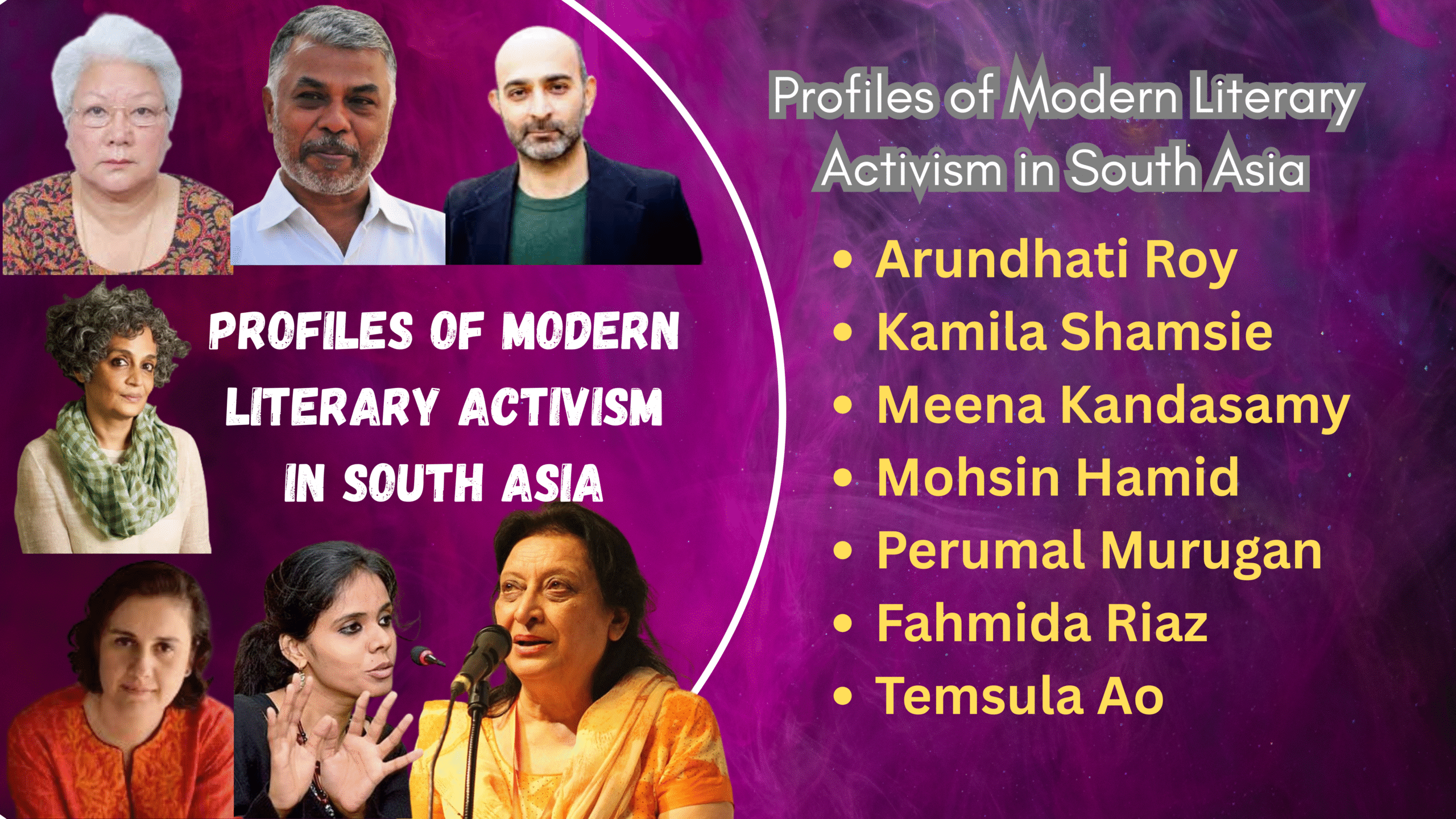Paish E Nazar – پیشِ نَظر
Columns by Hassaan Ahmad Awan

Profiles of Modern Literary Activism in South Asia
by Hassaan Ahmad Awan
In South Asia, literature has always been more than art — it has been a tool for shaping consciousness, challenging oppression, and preserving cultural memory. Modern literary activism in the region carries forward this tradition, adapting it to the digital age and to new political and social realities. From grassroots storytelling circles to transnational literary festivals, a diverse group of writers, poets, and cultural organizers are using words not only to inspire but to confront injustice head-on.
This profile-based exploration examines the work of some of the most significant literary activists in South Asia today — individuals whose writings extend far beyond the printed page to impact public thought, policy debates, and community resilience.
1. Arundhati Roy – Literature as Political Witness
Although Indian novelist and essayist Arundhati Roy is best known globally for her Booker Prize-winning debut The God of Small Things, her body of non-fiction has established her as one of the most fearless literary voices in the region. Roy has consistently used her platform to address issues ranging from environmental degradation to the displacement of marginalized communities and state violence in Kashmir.
Her activism is deeply intertwined with her writing style: personal narratives become political testimony, and political critique is sharpened by literary craft. Roy’s approach demonstrates how literature can hold power to account, not from a position of distance, but through deeply human storytelling.
2. Kamila Shamsie – Narratives of Migration, Identity, and Resistance
Pakistani-British novelist Kamila Shamsie has brought South Asian perspectives to global literary discourse, weaving themes of displacement, migration, and post-colonial identity into novels like Home Fire and Burnt Shadows.
While not an activist in the traditional sense of street protest, Shamsie engages in a subtler but equally important form of activism — reshaping the narrative space so that South Asian characters and histories are no longer peripheral but central. She frequently speaks out for diversity in publishing, particularly advocating for representation of voices from the Global South in English-language literature.
3. Meena Kandasamy – Poetry as Feminist Resistance
From Tamil Nadu, Meena Kandasamy exemplifies the use of poetry and prose as unapologetic feminist and anti-caste protest. Her works, including When I Hit You and Exquisite Cadavers, confront gender-based violence, caste oppression, and state complicity with a raw, fearless voice.
Kandasamy’s activism is not confined to the page. She is an outspoken presence on social media, participates in public debates, and uses literary events to create solidarity between feminist movements in South Asia and abroad. Her trajectory shows how literature can serve as both shield and spear for marginalized identities.
4. Mohsin Hamid – Storytelling for Empathy Across Borders
Pakistani novelist Mohsin Hamid has mastered the art of narrative empathy. Books like Exit West and The Reluctant Fundamentalist present political and social tensions through deeply personal lenses, encouraging readers to inhabit perspectives far removed from their own.
Hamid’s work functions as quiet activism — making migration, identity politics, and globalization’s discontents visible to an international readership without reducing them to mere news headlines. He frequently speaks in global forums about the need for literature to build bridges across cultural divides, especially in an era of increasing polarization.
5. Perumal Murugan – Defiance in the Face of Censorship
From Tamil literature, Perumal Murugan stands as a striking example of resilience. After facing severe backlash and threats over his novel One Part Woman, Murugan announced his “death” as a writer in protest against censorship. His eventual return to writing was itself an act of defiance, reclaiming his voice in the face of intimidation.
Murugan’s ordeal highlighted the fragile balance between creative freedom and societal conservatism in South Asia. His case became a rallying point for freedom of expression advocates across the region, proving how individual stories can ignite larger movements for artistic liberty.
6. Fahmida Riaz – The Poet Who Crossed Borders
Late Pakistani poet Fahmida Riaz used her verse to critique dictatorship, patriarchy, and religious extremism. Exiled during General Zia’s regime, she lived in India for several years, continuing to write poetry that resonated on both sides of the border.
Her literary activism lay in her refusal to separate art from conscience. By tackling taboo subjects and critiquing authoritarianism, she inspired a generation of South Asian women writers to claim their voices unapologetically. Riaz’s life illustrates that in South Asia, poetry can be both an intimate art and a form of public resistance.
7. Temsula Ao – Giving Voice to the Margins
From India’s Northeast, Temsula Ao (1945–2022) brought the region’s oral traditions and histories into the mainstream literary sphere. Her short stories and poetry reflect the struggles of marginalized communities often overlooked in the national narrative.
By chronicling everyday life in Nagaland alongside political violence and cultural resilience, Ao showed that literary activism also means archiving voices at risk of erasure. In her hands, storytelling becomes a way of safeguarding identity against the forces of cultural homogenization.
The Digital Turn in South Asian Literary Activism
While print remains powerful, the 21st-century South Asian literary activist increasingly leverages digital platforms. Online poetry collectives, Instagram-based literature journals, and virtual book launches now allow writers to bypass traditional gatekeepers and reach global audiences instantly.
Initiatives like Zubaan Books in India and Desi Writers’ Lounge in Pakistan curate spaces for new writers to address gender justice, minority rights, and environmental crises. These platforms blend traditional literary values with the immediacy of activism, proving that in the digital age, the activist pen is also a digital one.
Literature as Social Catalyst in South Asia
The profiles above reveal that South Asian literary activism is not monolithic. It ranges from the openly political protest writing of Meena Kandasamy to the nuanced narrative shifts of Mohsin Hamid, from the border-crossing solidarity of Fahmida Riaz to the hyperlocal cultural preservation of Temsula Ao.
What unites these voices is a belief that literature can — and must — engage with the realities of its time. In societies marked by political volatility, deep social inequalities, and contested histories, literary activism becomes a way to assert dignity, demand justice, and imagine alternative futures.
Lessons for Emerging Writers and Activists
For new writers in South Asia, these examples underscore that activism need not always be grand or confrontational. It can be embedded in the choice of subject, the centering of marginalized voices, or even the act of writing in a mother tongue.
In a region where books can still be banned, censored, or used as political bargaining chips, the courage to write is itself an act of defiance. Whether the arena is the global book market, a small poetry slam, or an online microfiction forum, South Asian literary activism continues to prove that words remain one of the region’s most enduring tools for transformation.
— — — — — — — — — — — — — — — — — — — — —
Hassaan Ahmad is a writer and digital content strategist who explores the intersections of literature, activism, and cultural memory in South Asia.
Urdu Version of The Column:



